Documentary : Environment
![]()
Capture the Wind – The Wind-Lens Turbine and the Future of Energy
DC221220![]()
風を集めて“レンズ風車”未来への挑戦 [RKB]
![]()
![]()
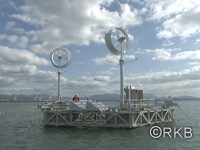
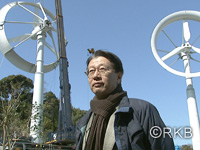
|Length : 46min. |Year : 2012 |
March 11, 2011—the day the Great East Japan Earthquake struck off the coast of Tohoku and caused a serious accident at the Fukushima No.1 Power Plant. Japan, which had relied on nuclear power for much of its energy, found itself at crossroads: how would it secure its energy future?
Coincidentally, this was the same day that two odd-shaped wind turbines were erected in Fukuoka City. The wind-lens turbine, a turbine with a unique brim surrounding its blades, was the brainchild of Kyushu University professor Yuji Ohya. Able to generate three times as much power as conventional wind turbines, it was a dream-inspiring machine. On the same day that Professor Ohya made his case for the need to shift to renewable energy, the Great East Japan Earthquake struck.
Previously, Professor Ohya had erected wind-lens turbines in China to provide energy for desert greenification, but they were destroyed, unable to withstand the harsh winds. As problems like these arose, Professor Ohya and his team resolved them one by one, gradually improving the turbine design.
With very few high wind areas on land, how can Japan increase wind power generation? According to Professor Ohya, the answer lies on the ocean. His dream is to use floating wind-lens turbines to create offshore energy farms. Experiments are now underway, and his team aims to build an offshore energy farm that will someday produce the same amount of power as a nuclear power plant.
This is the story of the researchers who worked tirelessly to develop the wind-lens turbine and the small factory workers who provided the technical support they needed. Above and beyond the goal of solving Japan's energy issues, their undertaking holds a clue for Japan's post-disaster recovery.
Believe in a Brighter Future: Nature’s Recovery after The Quake
DC221219![]()
グリーンキャンペーン 豊かな未来を信じて [KHB]
![]()
![]()
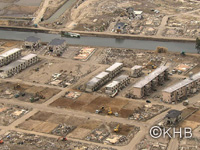
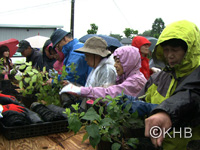
|Length : 46min. |Year : 2012 |
The Great East Japan Earthquake devastated the nature along the Miyagi Prefecture coastline. Will the rich ecosystems that once existed in the bays and estuaries ever return to their original state?
This program focuses on the Miyagi coastline nature through the actions of the people working together to restore it.
The Gamo Tidal Flat was once home to a treasure trove of precious plants and animals; a wetland region spread over 11 hectares at the entrance to the Nanakita River in northern Sendai city.
The bottom feeding animals and other creatures on the flat provided sustenance for the migratory birds, as they rested on their long journey. There were more than 10 species of crabs prior to the disaster, but the population has dropped severely.
However, scenes of rejuvenation were captured, such as the birthing scene of the red-clawed crab and other chance encounters with species thought lost in the disaster.
The Japanese honey bee is a symbol of the verdant Japanese countryside.
The children of Ishinomaki city have built hive boxes from the tsunami debris. These will be set up along the Miyagi coastline by an NPO group to see whether the bees remain active in the disaster area. It's hoped that the production of honey will lead to a rejuvenated economy and job creation in the region.
In the event that they don't attract any bees, there's also another project under way which aims to replant the bees' lost habitats.
In Watari town, locals have begun their dream of rebuilding the lost tide-control forest in a century-long project. 50 participants will take on the challenge of creating a new tide-control forest 400 metres wide and 4 km long.
Their dreams are slowly revealing themselves through the planning and discussions of what shape they'd like the new forest to take. The planting will officially begin from 2015 and beyond. The future trees are now seedlings being cultivated for their future role. The goal is to plant 100,000 hardwood and 100,000 Japanese black pine trees.
Although they will not be around when the next century arrives, the participants are working hard to leave a legacy that will remain for their children in the forest project.
Planting for the Future – Shirakami Mountains.JAPAN –
DC221218![]()
白神からのおくりもの [ATV]
![]()
![]()
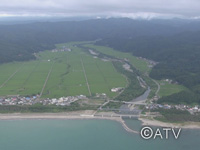
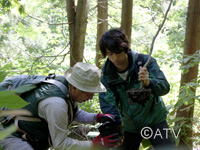
|Length : 46min. |Year : 2012 |
In 2013, the Shirakami Mountains Range marks its 20th year anniversary since it was designated as a UNESCO World Nature Heritage Site for the first time in Japan. The feature of Shirakami Mountains are one of the largest, primeval, beech tree forests in the world as well as broad-leaf tree forest which produces natural energy necessary for our life. However, bad behavior of tourist who visits there without knowing natural eco-system and growing cedar tree plantation of postwar era are said to have influenced natural eco-system of the Shirakami Mountains and its secondary forest.
This program covers a story of Mr.Katsuto Nagai, representative of NPO Shirakami Hitotsumori Natural School, who stays active in planting trees, aiming to restore/revitalize Shirakami Mountains to original state. For 19 years, they have planted beech trees, making their base in the village at downstream of Akaishi river running through the Shirakami Mountains Range. They uniquely plant and grow the beech trees all by themselves.
Beech tree bears fruit mostly every 5 year. Mr. K. Nagai and his fellows started to pick the fruit of beech tree. Meeting the difficulty in growing the fruit in secondary forest and taking a process of trial and error, they eventually became successful. Mr. K. Nagai based in secondary forest of Ajigasawa town of Aomori prefecture with less than 100 people, surrounded by mountain, river and sea, suffering from depopulation. He rented small abolished school there and collected fruit of beech tree with the resident for growing. New challenge he began from last year was to grow the fruit in a pot. Mr. Nagai quit his company to accomplish his dream of protecting natural eco-system in Shirakami Mountains. He intends to provide children with activities of forest and conducts classes of acquiring knowledge about culture of hunter, remaining in the nature of Shirakami Mountains and local area.
We have gathered information about Shirakami Hitotsumori Natural School for 1 year and half. Navigator is an actor, Mr. Takumi Saito who sympathizes with desire of those who are engaged in tree-planting activities in Shirakami Mountains Mr. Saito, having his home town in Tokyo, visits Shirakami Mountains Range and Hitotsunomori area to deliver the culture there and breadth of beech tree forest.
The Niyodo River – The Symphony in Blue –
DC221117![]()
仁淀川 ~知られざる青の世界~ [NHK]
![]()
![]()
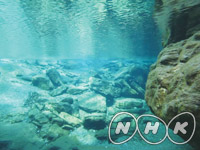
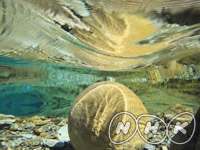
|Length : 43min. |Year : 2011 |
The 124-kilometer Niyodo River is the purest in all of Japan. It possesses a striking hue of blue known as Niyodo Blue that is a testament to the cleanliness of its waters, which have remained pristine despite serving the needs of 100,000 locals. The program vividly portrays the Niyodo through gorgeous photography captured with the latest technology and Masakatsu Takagi's evocative piano score.
The Niyodo remains blue from the forests that give it birth to its mouth. Along the way, its waters nurture the colorful wildlife that live in and around the river while also displaying a surprising expressiveness themselves. These aspects are filmed in meticulous detail with the help of guide Nobuyuki Takahashi, a photographer with intimate knowledge of the river. His camera captures a number of beautiful moments, from the glittering rime that serves as the Niyodo's source to the blue sheen that shrouds a plain brown dipper as it dives into the river.
This symphony in blue was composed to remind viewers that Japan is home to some of the most beautiful waters in the world, and that it is our duty to protect them even as the nation's rivers continue to be spoiled through industrial development.
What the Sea Turtles Teach Us
DC220916![]()
ウミガメが教えてくれること [MBC]
![]()
![]()

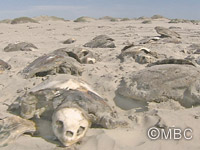
|Length : 72min. |Year : 2009 |
Sea turtles have lived on this planet for some 200 million years. A symbol of longevity and fertility, in Japan they appear in traditional folktales and are worshipped and admired. Research regarding sea turtles has revealed surprising results. Loggerhead sea turtles, born on Japan's beaches, travel to Mexico and after growing to maturity there, they return to Japan to lay their eggs. In the course of a lifetime, they travel roundtrip across the vastPacific Ocean.
In recent years, the number of sea turtles has declined to the point that they now near extinction, and on many beaches where they once laid their eggs, they can no longer be seen.
Making use of underwater, aerial and other footage of the abundant natural environment, this program documents the current status of the environment in which sea turtles live, and shows people who are making every effort to live side by side with sea turtles.















